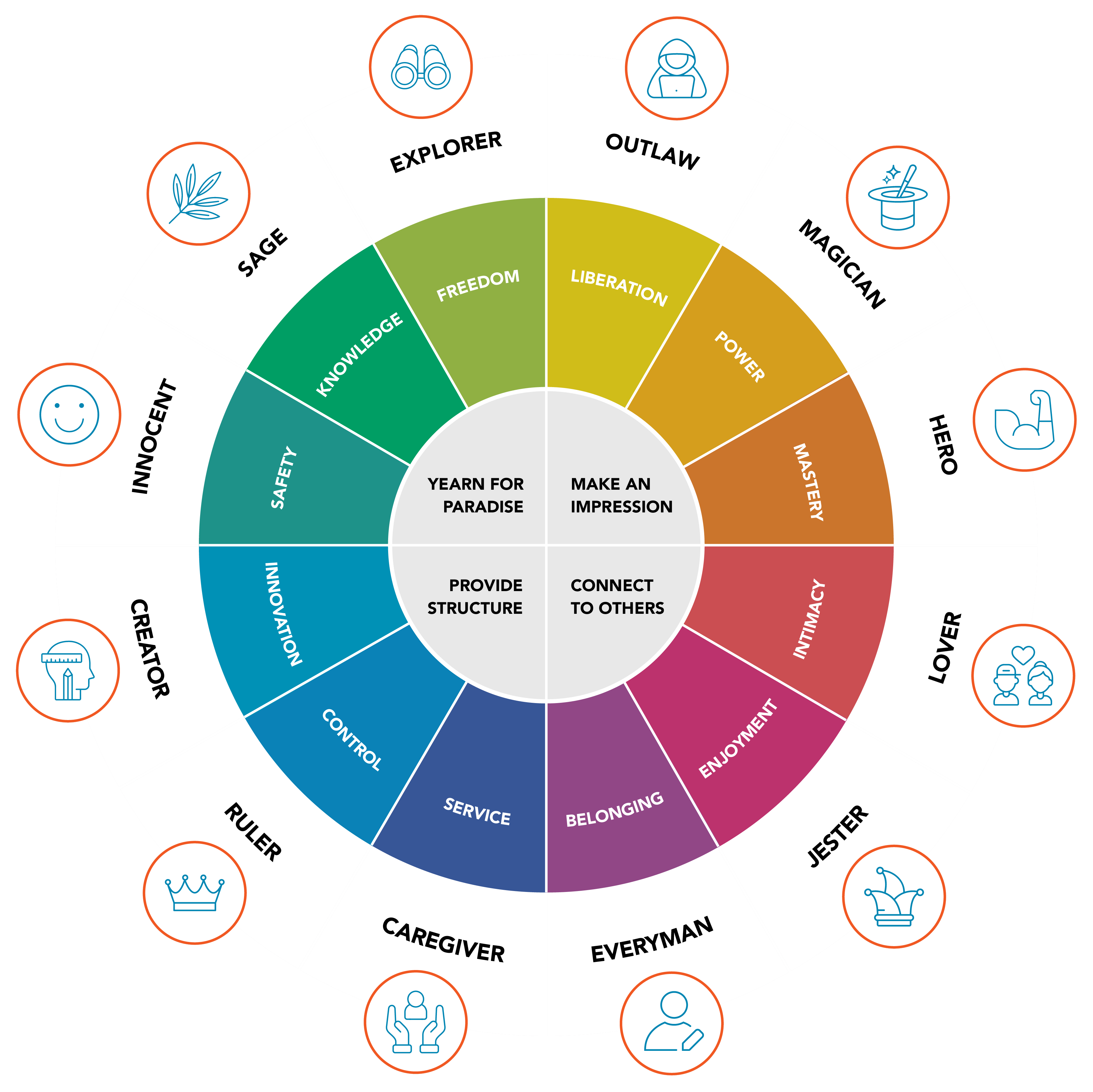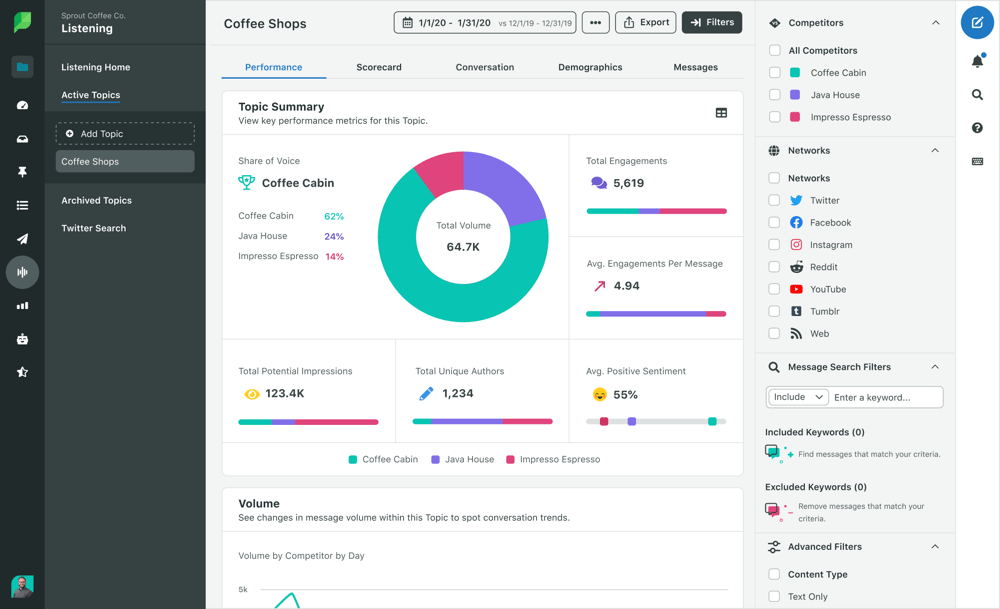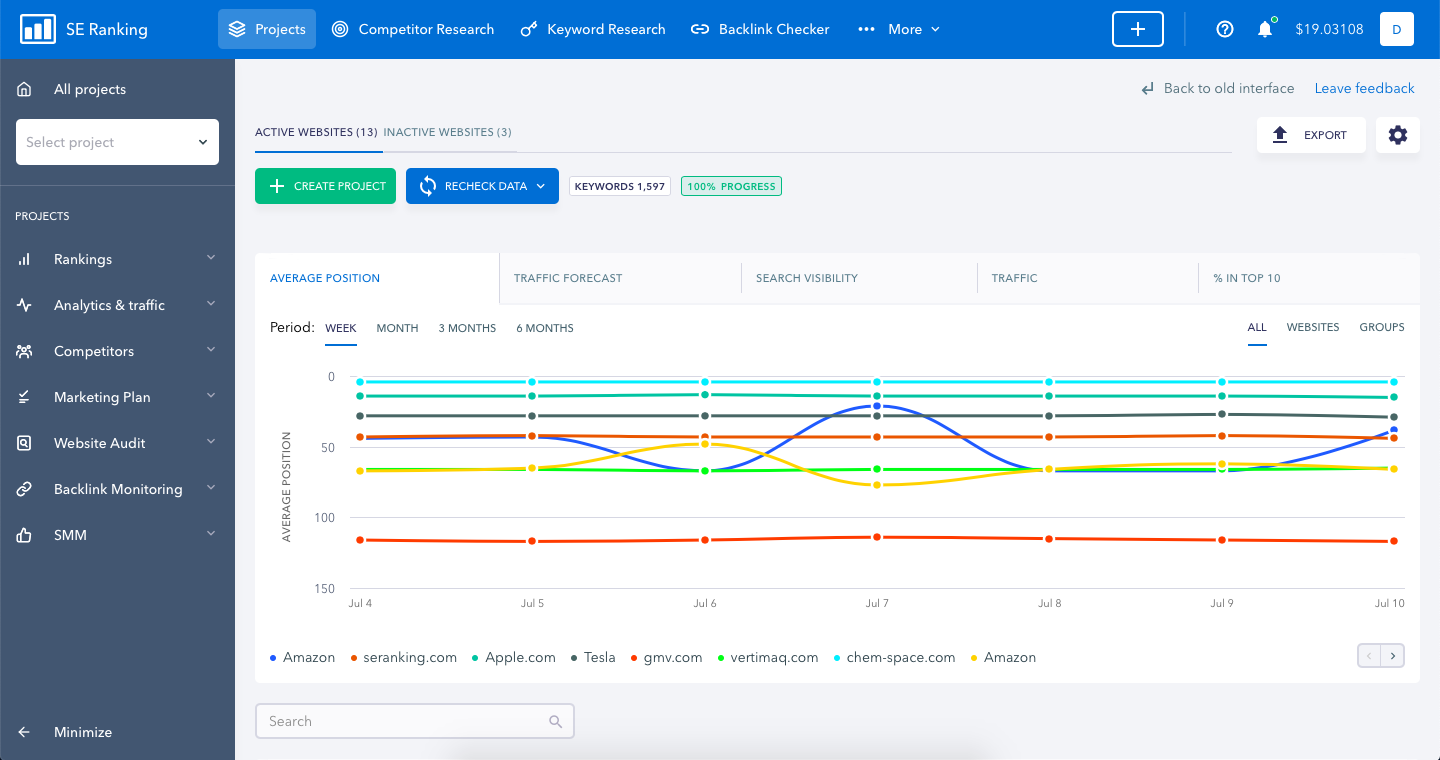
12 Brand Archetypes to Use & Turn Into Powerful Marketing Tools
Last update: 3 February 2023 at 04:07 pm
The correct implementation of brand archetypes in your marketing can change the way clients perceive your brand. In a world where emotions drive sales, you can turn this knowledge into a powerful marketing tool.
But, how to do it? Familiarize yourself with the 12 brand archetypes in this article and learn how to implement them.
Brand Archetypes Explained
There was a psychoanalyst you might have heard of — Carl Jung — who came up with 12 archetypes in 1919. Later on, digital specialists discovered that those archetypes could serve business and marketing needs.
A brand archetype is a collection of behaviors and characteristics that a person recognizes instinctively.
You correctly use the archetype if your audience feels belonging and has an emotional connection when interacting with your brand.
In marketing, brand archetypes should be an integral part of the brand strategy that allows clients to connect with a brand on a subconscious, emotional level. Showing the human side of a brand helps establish a meaningful connection and reveals brand personality.

Archetype as a Marketing Tool
In marketing, brand archetypes are the key to personal and strong brand identity. It’s been long known that emotions are what truly drive sales. As understanding archetypes is instinctive, it can influence your marketing.
With archetypes, you can understand the core motivations of your customers and answer the question:
‘Why do my customers truly need it?’ (product, service, etc.)
Once you understand the answer to that question, you can align your campaign’s efforts with the core desires of your perfect customer.
These efforts should also influence positions in search engines. With the help of archetypes, you can define the content most likely to cause interest and aim at the most targeted audience from the start.
Looking |
From 32,000 agencies, we narrow it down to only the ones you’ll love.
No commitment, 100% free.
How to Choose the Right Brand Archetype?
Choosing a brand’s archetype is similar to defining the company’s mission. Define your values and goals, and then reflect them on your brand. You should be honest with your audience.
Next, identify your customer persona, and connect the brand with that archetype. It should be based on your targeted audience’s behavior, desires, and values.
There are several ways to research your customers:
Social media
To get to know your customers better, you can analyze which posts they interact with most. Try using a SproutSocial social media management tool to get insights from your social media channels and build a thorough strategy.

Content
Another way to define a brand archetype is to understand what content interests your audience. If you don’t have an answer to this question, try using tools that will do the research for you.
One such tool is the SE Ranking SEO tool, where you can find the pages that gain the most traffic as well as the keywords that bring this traffic.
As the tool connects with Google Analytics data, you can get more information about where your traffic comes from and get to know your audience even better.

Client testimonials
What do your clients say about your brand? A brand monitoring tool such as Hootsuite will help you analyze feedback and make thoughtful marketing decisions.

12 Brand Archetypes and Examples
Let’s take a closer look at brand archetypes and how to work with them.
1. The creator brand archetype
Core desires
We all have a creative part living inside us, and brands can touch on that when it correlates with their values. Creators see things others don’t, have great imaginations, and chase innovations.
Niche
Anything to do with art, design, IT, writing, architecture.
How to apply
As the creator archetype focuses on authenticity and new approaches, your brand’s message should convey exactly that.
Audiences are willing to pay more for a product with advanced functionality and bold, creative solutions, which is why creator brands will catch their attention.
Examples of creator brands
Youtube, Apple, Adobe.
Adobe uses unusual, vivid fonts and turns a usual activity — like taking the subway — into a magical show where anything can happen. It is bold, modern, up-to-date, and certainly catches attention.
2. The sage brand archetype
Core desires
The sage brand archetype is known for wisdom — they seek knowledge and truth. They believe in making the world better with facts and quality information and have a desire to share their knowledge with others.
Niche
Media and news, educational business, search engines.
How to apply
The brand voice of the sage archetype should be bold and clear. You can catch your audience’s attention with valuable, high-quality information that includes facts, statistics, and numbers.
If you follow the archetype correctly, you will most likely gather loyal customers who will stay with you for many years.
Examples of sage brands
Google and Harvard.
Harvard is a symbol of high-quality education, intelligence, and community. Its promotion is straight-to-the-point, highlighting all the opportunities Harvard has to offer.
3. The caregiver brand archetype
Core desires
“Love your neighbor as yourself” is the caregiver’s motto. Its customers are warm, caring, and welcoming: they have an open heart and always hope for the best.
Niche
Non-profit organizations, education, and healthcare industries.
How to apply
Caregiver archetype is caring, businesses should focus on customer service and make sure that their clients are well taken care of. In promotions, you can appeal to family values and meaningful things, in which a person feels cared for and loved.
Examples of caregiver brands
WWF, Johnson & Johnson, Volvo, Huggies.
Volvo does a great job of focusing on the purpose of the video and revealing its idea in a way that evokes strong emotions.
4. The innocent brand archetype
Core desires
The audience that can relate to the innocent brand archetype believes in keeping life simple. They aim to do things right and desire a happy paradise.
Niche
Organic, skin products, cleaning, fresh food.
How to apply
Offer simple solutions to everything, from products to communication. Innocent branding strategy implies staying honest, and caring about the environment and the natural compositions of their products.
Examples of innocent brands
True Botanicals and Nestlé Pure Life.
5. The jester brand archetype
Core desire
Jesters want to have fun and want everyone around them to have fun as well. They are light-hearted characters who do not take life too seriously.
Niche
Entertainment, men’s care, alcohol, and game industries.
How to apply
Jester archetype aims to entertain the audience through humor and make them laugh. You can add memes, fun facts, and jokes to your brand identity.
Looking |
From 32,000 agencies, we narrow it down to only the ones you’ll love.
No commitment, 100% free.
Examples of jester brands
M&Ms, Old Spice and Mail Chimp.
M&Ms even have a collection of funny advertisements — they always lift the mood and make people smile.
6. The magician brand archetype
Core desires
Magicians aim to turn dreams into reality by creating unique visions. When interacting with such brands, customers feel like they can change the world, are interested in innovation, and are usually fond of nature.
Niche
Spirituality, coaching, health, wellness, entertainment.
How to apply
Brands with the magician brand archetype can use the desire for personal transformation to lead customers through a story. Such brands can easily add magical moments to their promotional campaigns.
Yet, edgy and extreme marketing campaigns can cause the wrong effect — it’s best to focus on the brand’s true purpose.
Examples of magician brands
Disney, Dyson, Coca-Cola, and TEDx.
In the promotional video from TEDx, check how they refer to change with phrases such as stretch beyond limits, push to try a little more, and inspire even more. You may notice they even have the light bulb in their logo, which itself was an innovative invention in the past.
7. The ruler brand archetype
Core desires
The ruler archetype is all about control, power, and authority. If you want to scare off a ruler, remind them of the possibility of being overthrown or causing chaos.
Most of the time, ruler brands consider themselves leaders of opinion, have a solid communication style, and possess the desire to create a successful, thriving society.
Niche
Luxury, hotels, formal wear, cars.
How to apply
Add the feeling of power to your advertising campaign, and you will catch the attention of a ruler. The good idea is to create an exclusive V.I.P community that gives a feeling of superiority and authority.
Examples of Ruler Brands
Mercedes-Benz, Rolex, Louis Vuitton, Rolls-Royce.
Let’s take a deeper look at the Mercedes-Benz 2020 promotion — see how laconic and straightforward it is. Notice what feelings the promotion evokes: the details, including the men’s wear, look, music, and the vibe of the city.
In the 1:04 minutes, the driver starts a conversation with the car, which adds to the authority and control. It gives a meta message: Driving Mercedes, you control not only the car but also your life.
8. The hero brand archetype
Core desires
Brands with a hero brand archetype enjoy challenges and are ready to do what it takes to reach their goals. The culture of the hero archetype focuses on being the best, chasing the top, achieving more, and outperforming competitors.
Niche
Sportswear and equipment, emergency trade services.
How to apply
Incorporate vivid colors, bold messages, and shapes into your advertising. If you want to get to the heart of the customer with the hero archetype, be honest, straightforward, and brave.
Examples of hero brands
Marvel, Nike, FedEx, BMV, Red Cross.
Phrases in Marvel’s promotions like “To greater glory”, and “When you love something, you fight for it“, make Marvel a symbol of bravery.
Creators appeal to the hero inside of viewers or to the desire to be like Marvel characters. Promotion lets viewers be a part of the heroic world, which creates emotional affection.
9. The regular guy brand archetype
Core desires
The regular guy strives for connections with others. Such personalities are looking for a sense of belonging and warmth, and you can use it to connect customers with the brand.
This archetype does not try to stand out and supports simple values where treating everyone equally is key.
Niche
Any niche that has to do with basic needs, family restaurants, shops, community centers, jeans, pickup tracks.
How to apply
Appeal to family values, enjoy the little things, and be a part of a harmonious society. Convey transparency and be helpful in your marketing efforts — it should be trustworthy and down-to-earth, without unnecessary fluff and luxury.
Examples of regular guy brands
GAP and IKEA.
In the IKEA ad, creators turn to many people with different social statuses, ages, and gender to create a sense of belonging and refer to ecological and family values.
10. The rebel/outlaw brand archetype
Core desires
The name of the archetype speaks for itself: they aim to disrupt the system, question it, break the rules, suggest radical ideas, and challenge societal norms.
Niche
Destruction tools, body art, automobile.
How to apply
The rebel brand archetype likes finding enemies, so the first thing to do is to prove that you see the world the same way. Avoid formal communication, celebrate revolution, and you will be accepted as a true rebel.
Examples of rebel/outlaw brands
MTV, PayPal, Robin Hood, Malcolm X and Harley-Davidson.
PayPal, for instance, took a somewhat strict industry and chose to add the rebel spirit to it. Look at the brave fonts, funky music, and revolutionary vibe the brand conveys.
It appeals to the idea of new money and overthrowing an old regime.
11. The explorer brand archetype
Core desires
Curiosity and independence lie at the heart of the explorer brand archetype. Such companies try to attract customers who want to live their lives to the fullest. These customers like to question their purpose in life and aim for freedom and excitement.
Niche
Outdoor activities and equipment for it, extreme sports, automobile industries.
How to apply
As explorers are risk-takers, you can create campaigns associated with extreme, dangerous activities. Focusing on strong emotions and exciting memories in the ad campaigns will also appeal to the right audience.
Examples of explorer brands
Red Bull, Jeep, and The North Face.
In their promotions, The North Face convey the exploration spirit from the very first second: visuals, inspiring speech, difficulties that characters face on their way to the top, and the spirit of adventure.
12. The lover brand archetype
Core desires
While brands that associate themselves with the lover archetype can be about romance, they can also be related to all intimate relationships: friendship, communication, and everything that supports close relationships. The lover brand desires to feel attractive and accepted by society.
Niche
Beauty, fashion, cosmetics industries.
How to apply
Aesthetic and eye-pleasing ads will create the best response. Add gold, red, and pink colors to strengthen the emotional response.
Focus on how your ideal customer will feel when applying the product, and convey those emotions.
Examples of lover brands
Chanel, Victoria’s Secret, Häagen-Dazs, and Hallmark.
Coco Chanel’s ad has everything: passion, strong emotions, self-confidence, and attractiveness.
Conclusion: Brand Archetypes’ Checklist
As you can see, archetypes can help your brand’s marketing efforts and strengthen your connection with your audience. Once you’ve analyzed your audience, find ways to interact with your customers relying on archetypes, and the change will not leave you waiting.
Wrapping up, go through the checklist to make sure you’re using brand archetypes in your marketing accurately:
- You know the values and can name the big idea of the brand.
- You understand your target audience well: their behavior, needs, deep motivations, and desires.
- Your values and marketing persona match your brand archetype.
- The niche of your brand corresponds to the brand archetype.
- You know how to reach your audience correctly using an archetype.
- You have a marketing plan in place that you are ready to adapt for further advertising campaigns.
- You have a list of ideas for your next ad.
If you have checked most of the boxes, you are all set to build a deep, meaningful connection with your audience.
Brand archetypes should be embedded into each aspect of your marketing strategy, involving content plan, advertising, brand message, and content development.





